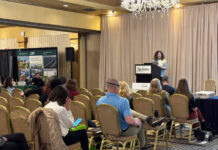When you were a kid did you get an Easter outfit? Buy new shoes? If your parents were like mine, you would have gone to the Lewis and Reilley Shoe Store, located on Wyoming Avenue, across from the Globe Store and next to the Scranton Dry Goods, to buy your new shoes.
The Lewis and Reilley Store had a remarkable new machine in the 1940s. You tried on a pair of new shoes and walked to this machine, which had two holes for your feet to go into. A light went on inside the machine and your feet were visible inside the shoes. The salesman checked the images to see if there was enough room for your feet to grow. I have no idea of the danger of such a machine but just for the fun of it, I tried on shoes and then raced to the machine to see what the inside of my foot looked like.
Parents have always known the importance of shoes. Many baby shoes were preserved in bronze, and lovingly placed on a shelf for all to see. These preserved shoes often had high tops, where the shoe didn’t stop beneath the ankle but came up the sides and over the ankle as further protection for young feet to grow.
In America, we have shoes for all occasions. Children have soccer shoes, baseball shoes, golf shoes with cleats, sandals for summer, boots for winter, sneakers for running and sneakers for playing. We are people lucky enough to have shoes – lots of them.
There are, however, 300,000,000, (three hundred million) children who have no shoes at all.
Countless more children wear shoes too small for them, squeezing into ill-fitting shoes, to make the shoes last longer.
Some of these children never had shoes, not ever. The feet of these children are susceptible to soil-transmitted diseases, parasites and bites from snakes and scorpions. Many of these diseases and parasites get into the body, just because no shoe is there for protection. Many children who don’t have shoes die of these diseases.
A few years ago, this shoe problem became apparent first hand to Kenton Lee, from Nampa, Idaho. After his graduation from Northwest Nazarene University, he traveled for better understanding of the world. One day while working and living at an orphanage in Nairobi, Kenya in Eastern Africa, Kenton saw a little girl in a white dress walking next to him. He was shocked at how small her shoes were. Her feet were squeezed into very tight shoes.
He kept thinking about this small child and came to the conclusion that she and many children like her needed shoes that could grow, as feet were constantly growing. When he returned to Idaho, he spoke about the idea to friends of how to make a shoe that would change as a child’s foot grew. In April 2009, he and his friends, founded a nonprofit organization called “Because International.”
Their first project was to develop The Shoe That Grows.
At the end of April, the Rotary Club of the Abingtons will join with other local Rotary clubs and share ideas at our District Conference and Lee will be our keynote speaker. For several months, we have been donating at each of our meetings to purchase these special shoes. Each pair costs $15. We will show our support to Kenton Lee at our District Conference. We will have collected enough money to further his project and buy 100-plus shoes.
If you would like to join us in this international project, go to the Abington Community Library and deliver $15 to librarian Leah Rudolph, who is also our Rotary treasurer.




